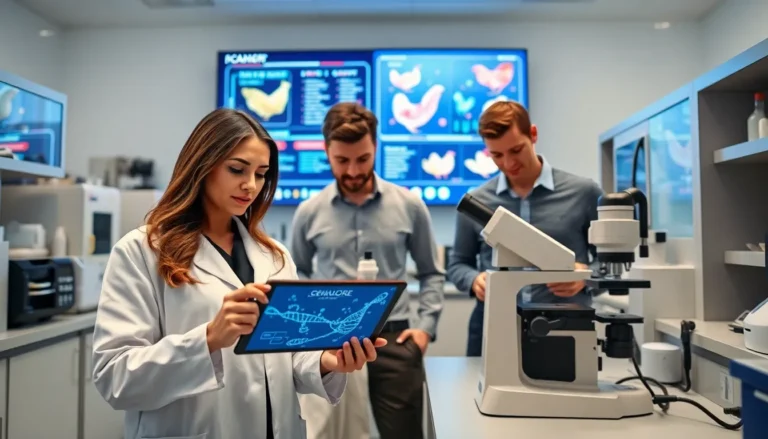In the ever-evolving world of biotechnology, patients often find themselves navigating a maze of jargon, research, and clinical trials. Enter biotech patient advocacy, the unsung heroes ensuring that patients aren’t just numbers on a chart but individuals with stories, needs, and voices. They’re like the GPS in a confusing city, guiding patients through the twists and turns of medical innovation.
These advocates are not just passionate; they’re armed with knowledge and a sprinkle of humor to lighten the serious side of healthcare. They bridge the gap between cutting-edge science and real-world patient experiences, making sure everyone understands that behind every breakthrough, there’s a human being waiting for hope. With biotech patient advocacy, it’s not just about the science; it’s about transforming lives, one informed decision at a time.
Table of Contents
ToggleUnderstanding Biotech Patient Advocacy
Biotech patient advocacy plays a crucial role in connecting biotechnology innovations with the experiences of individuals facing health challenges. Advocates work tirelessly to ensure that patient voices drive medical advancements and policies.
Definition and Importance
Biotech patient advocacy refers to efforts aimed at representing the interests and needs of patients within the biotechnology sector. These advocates serve as liaisons between patients and healthcare professionals, facilitating communication about treatment options and clinical trials. Their significance lies in enhancing patient understanding of complex scientific concepts while portraying each patient as a unique individual rather than a mere statistic. Effective advocacy promotes personalized treatment approaches, ensuring that patients’ perspectives inform research and regulatory decisions.
Key Players in the Field
Various stakeholders contribute to biotech patient advocacy, including nonprofit organizations, individual advocates, and patient groups. Nonprofit organizations often galvanize resources and create support networks for patients and their families. Individual advocates leverage their experiences to raise awareness and educate others about specific health issues. Patient groups unite individuals with similar conditions, fostering solidarity and amplifying their collective voice. These key players work together to promote informed decision-making and foster a patient-centric approach in biotechnology.
The Role of Biotech Patient Advocacy in Healthcare

Biotech patient advocacy plays a crucial role in healthcare by ensuring patients’ voices are heard in the biotechnology sector. Advocates help patients understand their rights and available treatments, promoting awareness of medical advancements.
Enhancing Patient Awareness
Advocates educate patients on complex biotech topics, simplifying scientific information into digestible formats. They create resources like webinars and brochures to improve understanding of therapies and clinical trials. By fostering community discussions, advocates encourage knowledge sharing among patients. Informational campaigns raise awareness of emerging treatments, empowering patients to engage actively in their healthcare decisions. Supporting patients with educational tools ensures they feel more confident when navigating their options.
Bridging the Gap Between Patients and Industry
Patient advocates serve as a connection point between the biotech industry and individuals affected by diseases. They communicate patient experiences and needs directly to biotech companies, ensuring those perspectives influence product development. Advocates also engage with regulatory bodies, voicing concerns and recommendations regarding policies that affect patient care. This collaboration promotes transparency and trust between stakeholders. By facilitating dialogues, advocates ensure innovations address real-world challenges faced by patients, ultimately leading to better healthcare outcomes.
Tools and Strategies for Effective Advocacy
Patient advocates utilize several tools and strategies to maximize their impact in biotech. These methods enhance engagement and ensure that patient voices shape the landscape of medical innovation.
Community Engagement Initiatives
Community engagement initiatives play a crucial role in biotech advocacy. These programs foster connections among patients, caregivers, and healthcare professionals. Events like support groups and informational workshops create supportive environments for shared experiences. Local gatherings, both in-person and virtual, encourage open dialogue about challenges and innovations in treatment options. Sharing personal stories helps humanize data and fosters empathy among stakeholders. Advocates often partner with community organizations to reach underrepresented populations, ensuring diverse voices contribute to evolving healthcare narratives.
Utilization of Digital Platforms
Digital platforms serve as powerful tools for biotech patient advocacy. Social media channels, such as Facebook and Twitter, enable advocates to share information quickly and widely. Online forums and blogs create space for discussions on specific conditions and treatments, enhancing peer support. Webinars and video content allow the dissemination of complex scientific concepts in accessible formats. By leveraging these platforms, patient advocates connect with larger audiences, amplifying their voices. Engaging in digital campaigns raises awareness of healthcare issues, driving action and change on multiple fronts.
Challenges Faced by Biotech Patient Advocates
Biotech patient advocates encounter several challenges that affect their ability to effectively represent patients. These obstacles often hinder progress and the implementation of solutions.
Navigating Regulatory Hurdles
Regulatory frameworks present significant challenges for advocates. Complexities in policies and guidelines may limit the ability to convey patient needs to decision-makers. Advocates often face difficulties in keeping pace with evolving regulations. They require a deep understanding of both scientific and legal aspects to effectively communicate concerns. Engaging with regulatory bodies demands not only knowledge but also persistence to ensure patient voices are heard.
Addressing Diversity and Inclusion
Ensuring diverse patient representation poses another challenge. Advocates strive to include voices from varied demographic backgrounds, reflecting the diverse patient population. Socioeconomic factors can create barriers to access for some individuals, impacting their participation in advocacy efforts. Advocates work diligently to bridge these gaps, creating inclusive environments. Building awareness around the importance of diversity strengthens the advocacy mission and enhances the overall effectiveness of the biotech sector.
Biotech patient advocacy is an essential component of the healthcare landscape. By bridging the gap between patients and the biotechnology sector, advocates empower individuals to navigate complex medical environments. Their efforts not only amplify patient voices but also foster collaboration among stakeholders.
The commitment to inclusivity and understanding ensures that diverse patient experiences are recognized and valued. As the biotech industry continues to evolve, the role of patient advocates will remain crucial in shaping policies and practices that prioritize patient needs. Ultimately, their work transforms lives by making healthcare more accessible and responsive to individual stories.










